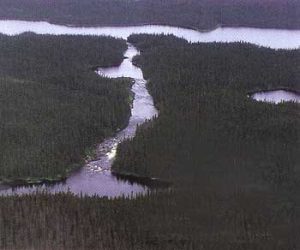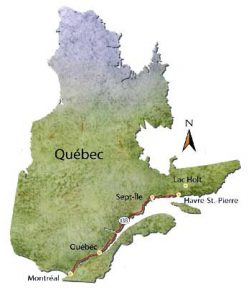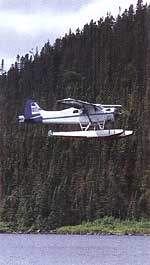Landlocked Salmon: “Ouananiche Country”

An aerial view, looking west, shows Lac Watshishou and the river that drains into Lac Holt. The large pool where the river makes a 90-degree turn is chock full of brook trout.
JUST BEFORE a floatplane leaves the water and takes to the air, there’s a moment of uncertainty and anticipation that never fails to take me by surprise. Despite the fact that I rode in such aircraft hundreds of times during my time as a guide in Alaska, I’m still not immune to the thrill of that instant. The transition from water to air is never as abrupt and defined as I expect it to be, and in those last seconds — when you can feel the lift in the wings even as the floats continue to skim the surface of the lake — the plane seems to be bridging the two elements of air and water. It’s only when this lingering tension finally breaks that I know I’ve left the security of civilization behind and am on my way into the unpredictable world of the bush.
It was with great excitement, then, that I and my friend Sandy Hays (who was along to take pictures) boarded a DeHavilland Otter last August, bound for Lac Holt. I hadn’t flown into the bush for several years, and I was eager to recapture that feeling of being surrounded by miles of wilderness in every direction. Although I knew virtually nothing about the region to which we were headed, I had been told that there were huge landlocks to be caught (Canadians call them ouananich), and that was enough to pique my interest.

Lac Holt lies 50 miles north of Havre-St.-Pierre on Québec's Côte Nord.
What really sold me on the idea of visiting Lac Holt and writing a story about it, however, was not the fishing opportunities. As regular readers of American Anglerare no doubt aware, we publish very few stories about remote lodges, because we believe that many of those destinations are beyond the means of the average fly fisherman. So when my friend Siegfried Gagnon, who works at Tourisme Quebec, told me of a remote lodge that costs about $200 a day, I was intrigued but skeptical. After all, most Alaskan lodges will set you back more like $800 a day. Not to mention that an East Coaster has to shell out another Grand in airfare just to get to the forty-ninth state.
I met up with the owners of Lac Holt, Gilles Marquis and Lisette Bouchard, at a fly-fishing show in Massachusetts, and just a short conversation convinced me that this was the real deal. They showed me maps of the territory, explained the various accommodation plans, and described the fishery. Having spent a lot of time listening to lodge owners puff up the fishing possibilities of their waters, I was pleasantly surprised by the candor of Gilles’ sales pitch.
“I tell people that this is not a trophy fishery,” he said, his thick accent belying the fact that he speaks near-perfect English. “There are many big trout and salmon — and many anglers catch them — but it is not like Alaska or the far north of Québec. What we offer is a wonderful wilderness experience and lots of fish. And there’s always the chance you’ll catch a giant.”
So I set off to Québec to see what kind of wilderness sporting experience you can have for less than the price of an average Manhattan hotel room.
The Other Bush
We Americans sometimes forget how massive Canada really is. When I broke out a map to scout the area I’d be fishing, I was amazed by the sheer size of Québec all by itself: it’s more than twice the size of Texas and measures more than 1200 miles from the U.S. border to the tip of the Ungava Peninsula. There’s plenty of territory stretching out to the east, as well, and that’s where we were headed.
Lac Holt is nestled among the ancient, rounded mountains some 50 miles northeast of Havre-St.-Pierre, which lies on Québec’s Côte Nord (“North Coast”). Havre-St.-Pierre — a 12 hour drive northeast of Québec City — is almost at the end of the road that parallels the St. Lawrence. (The fact that there is a road, however, means that, to visit Lac Holt, you need never get on a commercial flight, which cuts costs even further.)

Lodge owner Gilles Marquis fishes the river that connects Lac Watshishou and Lac Holt.
What was apparent once the floatplane began climbing away from Havre-St.-Pierre was that all civilization is clustered near the coast and the road. After just a couple minutes in the air, we were over uninhabited wilderness that stretches north uninterrupted into Labrador. The coastal plane soon gave way to hills, and then a range of mountains that run in parallel ridges, with many lakes and rivers between them.
Lac Holt Outfitters’ main lodge, which accommodates 8 guests, actually sits on the shores of Lac Watshishou — a huge, sprawling lake, which is more than a dozen miles long and which features many arms, bays, and coves. Its outlet is a 2-mile-long river that empties in Lac Holt, which then drains into Petit Lac Holt via an even shorter river. Lac Holt Outfitters has four other cabins spread around the territory, for guests who want more privacy and who are willing to bring their own supplies.
On the Water
After we dropped our gear off at the lodge, Gilles, Sandy, and I hopped into a boat and headed for the unnamed river that drains Lac Watshishou. Gilles told me that the best spot for trophy salmon was right at the top of the river, so we began by casting streamers there. The action was pretty slow at first — it was the middle of the day, after all — but I soon landed a couple of 12-inch salmon. Now that we’d gotten the skunk off, Gilles suggested that we go on a short hike to get a look at the river.
Because of the fragmented geography of the region, there are few long rivers that drain large areas in eastern Québec. Instead, there are thousands of lakes connected by short stretches of fast-moving water. The river between Lac Watshishou and Lac Holt is only a couple of miles long, but it contains dozens of rapids, riffles, and pools that make for perfect fish habit. The water reminded me of Maine’s Rapid River, where I first learned how to fish for landlocked salmon, so I immediately felt right at home.
Over the course of the next few hours, we’d hike for a few hundred yards, then fish for awhile, and then head downstream again. Everywhere we stopped, we caught fish — mostly small brook trout between 8 and 12 inches. At the final pool of the day, which formed at a 90-degree bend in the river — it seemed as though it was impossible to go three or four casts without catching a small brookie. They weren’t particularly choosy, either, striking streamers, nymphs, and dry flies with vigor.
When we headed back to the lodge that evening, Gilles pointed out some spots where he’d caught huge fish, including a 10-pound ouananiche. Although we hadn’t seen any big trout or salmon on our first day, I was impressed by the sheer number of fish. I’ve never had one of those mythical 100-fish days, but I bet it’s possible if you had a good day that river.
The Hunt Begins
We spent the next couple of days exploring all the various waters within striking distance of the lodge with Lisette’s son Maxime, who serves as a part-time guide whenever he’s out at the lodge. We took a boat trip to the far northern end of the lake, where impressive cliffs rise several hundred feet out of the water, and we landed a bunch more small brookies at the bottom of a gorgeous waterfall where a tributary empties into the lake. When we took a break from fishing, we simply absorbed the beauty of our surroundings and enjoyed the sense of isolation you feel when you’re many miles from the nearest road.
We spent another afternoon hiking to one of the many ponds in the area, where we cast to the forested shoreline from float tubes. Unfortunately, we had caught just a couple of trout when the wind came up so strong that it was impossible to keep from getting blown across the water — away from our launching spot, of course. It was all Max and I could do to make it back to shore without collapsing from exhaustion.
On our third day, we flew down to one of the remote cabins, and from there we took a boat to the outlet of Petit Lac Holt, a spot which turned out to be full of brook trout much larger than those we’d caught before. These fish were suckers for anything purple fished deep, and we enjoyed a few hours’ of good action before we had to head back. Maxime landed the largest fish of the day, a gorgeous 16-inch beauty with brilliant red spots ringed in blue along its sides.
In the first few days at Lac Holt, we caught many landlocks between 12 and 16 inches, but, try as we might, we couldn’t find one of the really big salmon for which the region is known. Maxime suggested that, because the weather was so unusually fair — we were suffering cloudless skies and temperatures in the 70s — the salmon were hunkering down in deep water. This was confirmed by Pierre Warren, a guest from Montréal, who had brought a fish finder to the lodge. He said that he had detected tons of fish in the lake, but that they were holding too deep to catch on a fly. Obviously all the big fish weren’t in deep water, however, for one of the other guests — Payson George, from Skowhegan, Maine — took the first trophy, a 25-inch salmon, on the second day.
On the Troll
The method that Payson employed to hook his big fish — trolling a streamer behind the boat — turned out to be the key to catching larger salmon during the time we were at Lac Holt. Because there is so much water to cover on Lac Watshishou, trolling is the best way to find fish when you’re not fishing to obvious structure or in a spot where there is a noticeable current. Although I grew up pulling flies behind a canoe on the ponds of New Hampshire, my home state, I had initially resisted trolling on this trip, simply because I enjoy the process of casting, mending, and retrieving a fly much more. Both Gilles and Maxime had told me that many large salmon are caught each year by casting anglers, but that most real hogs are taken by trolling anglers.

A DeHavilland Otter bound for Lac Holt.
So Maxime, Sandy, and I set out on the evening of our fourth day with a single goal in mind: to see if we could troll a streamer to entice one of those big salmon at the outlet of Lake Watshishou, where we had started with Gilles on the first day. Maxime had given me a fly of his own design, the Holt Special, and he assured me that the salmon couldn’t resist it. We trolled back and forth across the top of the river, and, although we took several decent fish, none of them was the big boy we were looking for.
It was starting to get dark, so we decided to make one more pass and then head back to the lodge. Sure enough, our giving up was all it took for the fish to turn on. A jarring strike almost tore the rod out of my hands, and I could tell immediately that it was a good fish. I asked Maxime to beach the boat, and I quickly hopped out so I could fight the salmon from shore.
The fish made several strong runs, but it never jumped; this, said Maxime, was a sure sign of a real trophy. When I had finally played the fish close enough that I could see it, I was shocked by its dimensions: it was the largest landlocked salmon I’d everseen, never mind caught. In all the times I’d fished for landlocks in Maine and New Hampshire, I’d never been able to break the 20-inch mark. When we put the tape to this fish, it measured more than 26 inches, and the girth was equally impressive. The coloration and markings of the salmon were remarkably beautiful, and I could feel its strength and wildness as I held it in my hands. We snapped a few shots in the fading light, and then I put the fish back in the water and watched it swim away.
That turned out to be the only monstrous fish that we caught in five days at Lac Holt, but we certainly landed dozens of trout and salmon in the 10- to 15-inch range. And during the time we were at the lodge, every guest took at least one fish over 24 inches. Given that we had unseasonably warm weather and bright sun, I think the fishery showed its quality.
But more than the fishing, it was the grandeur and the wildness of the place that stayed with me — the silence and the intensely dark nights that can only be found far from civilization. Aside from those of us staying at the lodge, we did not see a single soul, which made the place seem even more remote. Add all that up, and the fishing is just a bonus.











